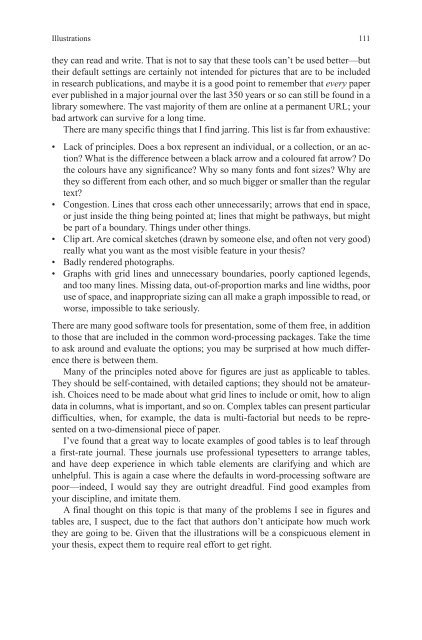How-to-Write-a-Better-Thesis
Create successful ePaper yourself
Turn your PDF publications into a flip-book with our unique Google optimized e-Paper software.
Illustrations <br />
111<br />
they can read and write. That is not <strong>to</strong> say that these <strong>to</strong>ols can’t be used better—but<br />
their default settings are certainly not intended for pictures that are <strong>to</strong> be included<br />
in research publications, and maybe it is a good point <strong>to</strong> remember that every paper<br />
ever published in a major journal over the last 350 years or so can still be found in a<br />
library somewhere. The vast majority of them are online at a permanent URL; your<br />
bad artwork can survive for a long time.<br />
There are many specific things that I find jarring. This list is far from exhaustive:<br />
• Lack of principles. Does a box represent an individual, or a collection, or an action?<br />
What is the difference between a black arrow and a coloured fat arrow? Do<br />
the colours have any significance? Why so many fonts and font sizes? Why are<br />
they so different from each other, and so much bigger or smaller than the regular<br />
text?<br />
• Congestion. Lines that cross each other unnecessarily; arrows that end in space,<br />
or just inside the thing being pointed at; lines that might be pathways, but might<br />
be part of a boundary. Things under other things.<br />
• Clip art. Are comical sketches (drawn by someone else, and often not very good)<br />
really what you want as the most visible feature in your thesis?<br />
• Badly rendered pho<strong>to</strong>graphs.<br />
• Graphs with grid lines and unnecessary boundaries, poorly captioned legends,<br />
and <strong>to</strong>o many lines. Missing data, out-of-proportion marks and line widths, poor<br />
use of space, and inappropriate sizing can all make a graph impossible <strong>to</strong> read, or<br />
worse, impossible <strong>to</strong> take seriously.<br />
There are many good software <strong>to</strong>ols for presentation, some of them free, in addition<br />
<strong>to</strong> those that are included in the common word-processing packages. Take the time<br />
<strong>to</strong> ask around and evaluate the options; you may be surprised at how much difference<br />
there is between them.<br />
Many of the principles noted above for figures are just as applicable <strong>to</strong> tables.<br />
They should be self-contained, with detailed captions; they should not be amateurish.<br />
Choices need <strong>to</strong> be made about what grid lines <strong>to</strong> include or omit, how <strong>to</strong> align<br />
data in columns, what is important, and so on. Complex tables can present particular<br />
difficulties, when, for example, the data is multi-fac<strong>to</strong>rial but needs <strong>to</strong> be represented<br />
on a two-dimensional piece of paper.<br />
I’ve found that a great way <strong>to</strong> locate examples of good tables is <strong>to</strong> leaf through<br />
a first-rate journal. These journals use professional typesetters <strong>to</strong> arrange tables,<br />
and have deep experience in which table elements are clarifying and which are<br />
unhelpful. This is again a case where the defaults in word-processing software are<br />
poor—indeed, I would say they are outright dreadful. Find good examples from<br />
your discipline, and imitate them.<br />
A final thought on this <strong>to</strong>pic is that many of the problems I see in figures and<br />
tables are, I suspect, due <strong>to</strong> the fact that authors don’t anticipate how much work<br />
they are going <strong>to</strong> be. Given that the illustrations will be a conspicuous element in<br />
your thesis, expect them <strong>to</strong> require real effort <strong>to</strong> get right.














![[Lonely Planet] Sri Lanka](https://img.yumpu.com/59845622/1/169x260/lonely-planet-sri-lanka.jpg?quality=85)


